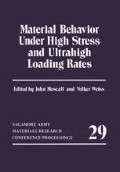Abstract
A brief review is presented of strain rate history and temperature history effects during the high strain rate deformation of metals with special emphasis on the BCC metals. Possible explanations to account for history effects are reviewed. Experiments are described in which single crystals of aluminum are deformed at various strain rates. Observations by transmission electron microscopy are used to relate microscopic to macroscopic behavior. Results show that cell size influences the strain rate sensitivity and may be a cause of history effects.
Access this chapter
Tax calculation will be finalised at checkout
Purchases are for personal use only
Preview
Unable to display preview. Download preview PDF.
References
J. E. Dorn, A. Goldberg and T. E. Tietz, “The Effect of Thermal- Mechanical History on the Strain Hardening of Metals”, AIME Trans., Vol. 180, pp. 205–224, 1949.
U.S. Lindholm “Some Experiments with the Split Hopkinson Pressure Bar”, J. Mech. Phys. Solids, Vol. 12, pp. 317–335, 1964
J. Duffy, “The J. D. Campbell Memorial Lecture: Testing Techniques and Material Behaviour at High Rates of Strain”, Proc. Conf. on Mechanical Properties at High Rates of Strain, 1979, Edited by J. Harding, The Institute of Physics, Bristol and London, 1980, pp. 1–15.
R. A. Frantz, Jr. and J. Duffy, “The Dynamic stress-Strain Behavior in Torsion of 1100–0 Aluminum Subjected to a Sharp Increase in Strain Rate”, J. Appl. Mech., Vol. 39 pp. 939–945, 1972.
P. E. Senseny, J. Duffy, and R. H. Hawley, “Experiments on Strain Rate History and Temperature Effects During the Plastic Deformation of Close-Packed Metals”, J. Appl. Mech., Vol. 45, pp. 60–66, 1978.
T. Nicholas, “Strain-Rate and Strain-Rate-History Effects in Several Metals in Torsion”, Experimental Mechanics, Vol. 11, No. 8, pp. 370–374, 1971.
J. D. Campbell and J. Duby, “Delayed Yield and Other Dynamic Loading Phenomena in a Medium-Carbon Steel”, Proc. Conf. on Properties of Materials at High Rates of Strain, The Institution of Mechanical Engineers, London, pp. 214–220, 1957.
J. Harding, Discussion of paper by Klepaczko and Duffy, in Pro. Conf. on Mechanical Properties at High Ratés of Strain, The Institute of Physics, London, p. 191, 1974.
A. M. Eleiche and J. D. Campbell, “The Influence of Strain- Rate History and Temperature on the Shear Strength of Copper, Titanium and Mild Steel”, University of Oxford, Report AFML-TR-76–90, 1976.
J. Klepaczko and J. Duffy, “Strain Rate History Effects in Body-Centered-Cubic Metals”, Proc. Conf. on Mechanical Testing for Deformation Model Development Ed. by R. W. Rohde and J. C. Swearengen, ASTM STP 765, pp. 251–268, 1982.
J. D. Campbell and T. L. Briggs, “Strain-Rate History Effects in Polycrystalline Molybdenum and Niobium”, J. Less Common Metals, Vol. 40, pp. 235–250, 1975.
J. Klepaczko and J. Duffy, “History Effect in Polycrystalline BCC Metals and Steel Subjected to Rapid Changes in Strain Rate and Temperature”, Brown University Technical Report, June 1982. To be published in Archives of Mechanics, Warsaw, Poland, No. 4, 1982.
T. C. Lindley, “The Effect of a Pre-Strain on the Low Temperature Mechanical Properties of a Low Carbon Steel”, Acta Met., Vol. 13, pp. 681–689, 1965.
R. C. Smith, “Studies of Effect of Dynamic Preloads on Mechanical Properties of Steel”, Experimental Mechanics, Vol. 1, No. 11, pp. 153–159, 1961.
A. S. Keh and S. Weissmann, “Dislocation Substructure in Body- Centered-Cubic Metals”, Chapter 5 in Electron Microscopy and Strength of Crystals Ed. by G. Thomas and J. Washburn, Interscience, New York, 1963.
W. C. Leslie, J. T. Michalak, and F. W. Aul, “The Annealing of Cold-Worked Iron”, Proc. Conf. on Iron and Its Dilute Solid Solutions Ed. by C. W. Spencer and F. E. Werner, Interscience, 1963.
P. R. Swann, “Dislocation Arrangements in Face-Centered Cubic Metals and Alloys”, Chapter 3 in Electron Microscopy and Strength of Crystals, Ed. by G. Thomas and J. Washburn, Interscience, New York, 1963.
H. J. McQueen and J. E. Hockett, “Microstructures of Aluminum Compressed at Various Rates and Temperatures”, Met. Trans. A, Vol. 1, pp. 2997–3004, 1970.
A. Korbel and K. Swiatkowski, “The Role of Strain Rate in Formation of Dislocation Structure and Its Influence on the Mechanical Properties of Aluminum”, Met. Sci. J., Vol. 6, pp. 60–63, 1972.
M. R. Staker and D. L. Holt, “The Dislocation Cell Size and Dislocation Density in Copper Deformed at Temperatures between 25 and 700 C”, Acta Met., Vol. 20, pp. 569–579, 1972.
C. Y. Chiem and J. Duffy, “Strain Rate History Effects and Observations of Dislocation Substructure in Aluminum Single Crystals Following Dynamic Deformation”, Brown University Technical Report, NSF MEA 79–23742/3 and MRL E-137, October 1981.
J. Lipkin, J. D. Campbell and J. C. Swearengen, “The Effects of Strain-Rate Variations on the Flow Stress of OFHC Copper”, J. Mech. Phys. Solids, Vol. 26, pp. 251–268, 1978.
D. L. Holt, “Dislocation Cell Formation in Metals”, J. Appl. Phys., Vol. 41, No. 8, pp. 3197–3201, 1970.
T. H. Alden, “Microstructural Interpretation of Work Softening in Aluminum”, Met. Trans. A, Vol. 7, pp. 1057–1063, 1976.
A. P. L. Turner and T. Hasegawa, “Deformation Microstructures and Mechanical Equations of State”, Proc. Conf. on Mechanical Testing for Deformation Model Development, Ed. by R. W. Rohde and J. C. Swearengen, ASTM STP 765, pp. 322–341, 1982.
R. W. Rohde, W. B. Jones and J. C. Swearengen, “Deformation Modeling of Aluminum: Stress Relaxation, Transient Behavior and Search for Microstructural Correlations”, Acta Met., Vol. 29, pp. 41–52, 1981.
Author information
Authors and Affiliations
Editor information
Editors and Affiliations
Rights and permissions
Copyright information
© 1983 Plenum Press, New York
About this chapter
Cite this chapter
Duffy, J. (1983). Strain Rate History Effects and Dislocation Substructure at High Strain Rates. In: Mescall, J., Weiss, V. (eds) Material Behavior Under High Stress and Ultrahigh Loading Rates. Sagamore Army Materials Research Conference Proceedings, vol 29. Springer, Boston, MA. https://doi.org/10.1007/978-1-4613-3787-4_2
Download citation
DOI: https://doi.org/10.1007/978-1-4613-3787-4_2
Publisher Name: Springer, Boston, MA
Print ISBN: 978-1-4613-3789-8
Online ISBN: 978-1-4613-3787-4
eBook Packages: Springer Book Archive

